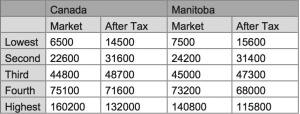by Ian Hudson
According to CBC news, 45% of Canadians wait until the last week before the deadline to file their tax returns. The mad pencil sharpening, digging through receipts and online filing is unlikely to generate a great deal of goodwill towards the tax collector. Perhaps this is why the Winnipeg Free Press chose April 30th to run two anti-tax View from the West editorials from the Fraser Institute and Canadian Taxpayers Federation. The Fraser Institute claimed that Canadians paid lots of taxes, the Taxpayer Federation argued that the provincial NDP had a bad spending problem and that we should be braced for “more NDP tax increases.”
While these articles are correct in arguing that government should be accountable and that we need to know how much tax we are paying (and just who is paying them) simply totting up taxes paid without also acknowledging what we get for them would be like leaving the grocery store enraged at your bill without noticing that there was a bunch of food in your cart.
The Fraser Institute article was especially misleading on this front. It diligently added up every dime that Canadians paid the government. Yet there was no acknowledgement that the government also transfers income to Canadians. In fact, the redistributive function performed by government ensures that all Canadians meet some sort of basic standard of living.
According to Statistics Canada, in 2009, the average Canadian family of two people or more received a tidy $10,200 in transfers from all levels of government. Importantly, lower income families received more than richer ones. The average family in the bottom 20 percent of Canadian income earners received over $14,000, while the richest 20 percent got a much more modest $5,800 (1). Merely adding up taxes going to government, without including transfers from government, creates a badly misleading picture on the supposed costs of the state.
It is not overly complicated to get a picture of just who benefits from the tax and transfer system. The table below compares the income earned from “market” sources like your job and income from investments and what Statistics Canada calls after tax income, which is your market income plus the transfers that you get from government minus income tax. Note that this does not include all taxes, like sales or property tax for example, so it is not a complete measure of what government puts in, and takes out, of people’s pocket. But it does provide an illustration of how people of different incomes are affected by the government.
In both Manitoba and Canada as a whole, those in the lower income distributions receive far more in transfers than they pay in income taxes. As we go up the income ladder, the government offers less in transfers and takes more in taxes. If the government did not transfer income, or collect income taxes, the average income of the richest 20% of Canadians would have been 25 times the average income of the poorest 20%. After income tax and transfers that number is only 9 times.
The same is true for Manitoba. The average market income of the richest 20% of Manitobans is 19 times that of the poorest 20%. For after tax income, the ratio is a much more modest 7 times. So, examining only what we pay, as the Fraser Institute does, ignores the fact that the government uses some of what it takes to give back to families. Further, in its giving and taking, it creates a much more equal society. Unfortunately, it appears that this crucial role is being compromised and is not helped by editorials like those in the Free Press. One Statistics Canada study in 2009 found that after 1995, the tax and transfer system has become less redistributive, particularly due to changes in social assistance levels (2).
Of course, this calculation only includes one form of government benefit – income transfers. It excludes all of the other benefits that we receive from the government in the form of goods and services, many of which benefit all Canadians. To provide just one example, the average American family paid just over $13,000 for health insurance in 2009 (3). Canadians receive the benefit of health insurance when they pay their taxes.
In fact, government is much better suited to providing some goods and services than the current private sector provision, which would create a case for tax increases. One quick example is tree banding, which used to be provided by the City of Winnipeg. Courtesy of municipal cutbacks, tree banding on Winnipeg boulevards is now left up to the individual homeowner, a ridiculous state of affairs since just one non-banding neighbour can ruin the tree protecting efforts of the rest of the block. The principles underlying the irrationality of private provision in this simple, but familiar, case extend to many other goods and services.
Ignoring what we receive in return for our taxes ignores the fundamental tenet of tax policy, which is to tax fairly and spend wisely.
Notes
1 Statistics Canada. Government Transfers and Income Tax. http://www.statcan.gc.ca/tables-tableaux/sum-som/l01/cst01/famil88a-eng.htm
2 Frenette, M., Green, D. and Milligan, K. “Looking for Smoking Guns: The Impact of Taxes and Transfers on Canadian Income Inequality,” p. 30.
3 Fritze, J. 2009. “Average Family Insurance Policy $13,375” USA Today, September 16. http://www.usatoday.com/money/industries/health/2009-09-15-insurance-costs_N.htm



